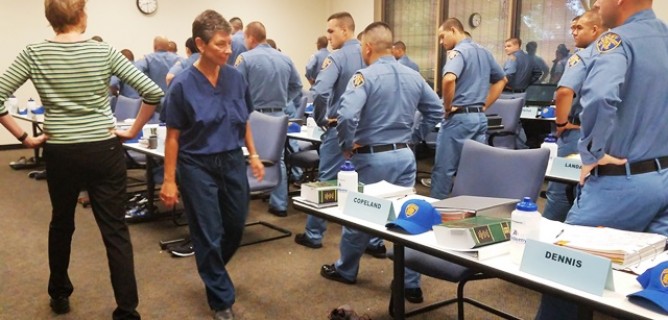By Annette “Dr Z” Zaharoff, M.D.
I recently taught another injury prevention class at the San Antonio Police Academy with Julie Barnett, the Director of Physical Therapy here at the Non-Surgical Center of Texas.
I’ve been doing this voluntarily once or twice a year for about 15 years, and it always feels good to give back. My brother, Fred Zaharoff, was a police officer in Detroit. He often told me about how rigorous his training was as he had to log countless miles running and scrambling through obstacle courses.
And while Fred certainly learned self-defense, he received almost no training on how to prevent injuries.
Tragic stories about police officers who are injured or killed in the line of duty are thankfully not that common, but we all have heard them. More common, but heard about less often, are more common-place injuries that police officers receive in the course of doing their every day jobs.
Sprained ankles. Stress fractures. Shin splints. Knee pain. Tendinitis. Dislocated shoulders. These are the realities that many police officers face every day due to the physical demands of the job.
Preventing injuries is a big part of what we teach our patients at the Non-Surgical Center of Texas. I wanted to find a way to give back, so I contacted the police academy and offered our services. To their credit, the San Antonio Police Department was very interested and proactive in working with us to present a curriculum to help prevent injuries in their cadets, and after they take the oath to protect and serve.
Being a police cadet is not unlike being a cadet in the military. A serious injury during the course of academy training could sideline them, meaning that trainee likely will be “recycled” and will have to go through another academy class, or they don’t become a San Antonio police officer.
The class we teach consists of a traditional classroom presentation, a demonstration of proper stretching techniques, a check of hamstring flexibility, and an important discussion about shoes.
We tell the cadets to bring a pair of their athletic shoes to the class, and we help them determine whether they are a good fit for their rigorous training regimen. For example, a bad fit in running shoes can lead to runner’s knee, or a decrease in strength in your quadriceps, which can lead to a host of other problems.
Shoes are a critical piece of police equipment. The shock absorbency of running shoes diminishes by 25 percent after 50 miles, by 33 percent after 100-150 miles and by 40 percent after 225 miles. When you consider that a 150-pound person can put 120 tons of force on their feet over the course of a single mile, the importance of having good, shock-absorbent becomes more than clear.
Julie and I believe in what we do at the clinic, and we’d like to believe that the course we teach at the San Antonio Police Academy makes a difference in the quality of their service to our community.
It feels like helping family. Police officers like my brother put their lives on the line for us. This is the least I can do to support the health and fitness of cadets and future officers.
Dr. Annette “Dr. Z” Zaharoff heads the Non-Surgical Center of Texas, focusing on non-surgical treatments to relieve pain and repair injuries. A former professional tennis player who competed on the WTA circuit, Dr. Zaharoff has been utilizing regenerative injection treatments including Stem Cell Therapy, PRP Injection Therapy and Prolotherapy for more than a decade. Learn more about her at www.drzmd.com. You can follow her on Facebook at www.Facebook.com/DrZaharoff.
###

